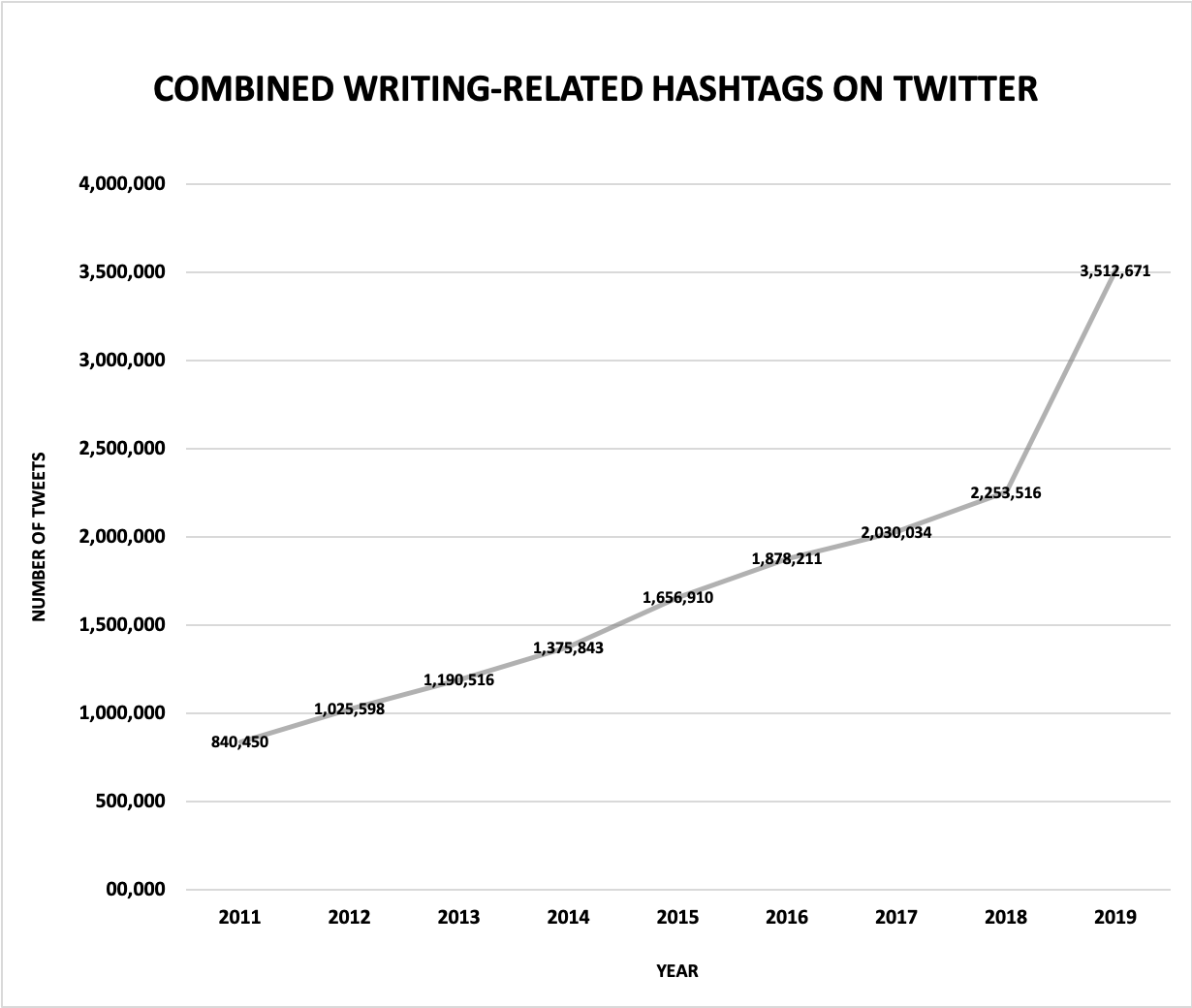
The Project TwitLit team scraped Twitter for a total of thirty-five terms (ten related to the writing community and twenty-five related to forms of writing) between January 2011 and December 2019. Combining these terms into a single graph, we can see that the use of Twitter as a platform for the writing community increased steadily between 2011 and 2018 before suddenly shooting up in 2019, in which year there were over 3.5 million tweets related to this community.

Graph 1: Writing-related Hashtags on Twitter
from 2011 through 2019.
Yet more than just showing that Twitter is increasingly being used as a platform to connect the writing community, the data we collected yields four primary observations about the trends in this community:
Let's look at each of these implications in turn.
Duplicate Hashtags
Twitter users often use multiple hashtags within a single tweet. As such, when combining all of the data to show larger trends within the writing community on Twitter (as in Graph 1), each instance of a hashtag would be counted as a separate data point. For instance, in his Twitter poem about raindrops, Eric Liu tagged his tweet with five hashtags: #5lines, #tanka, #poetry, #micropoetry, and #poem (see Image 1). When we scraped Twitter for the hashtags #5lines, #tanka, and #micropoetry, Liu’s poem was counted once in each of these categories. When we combined all of these files into a single master file for all fiction and poetry tweets, Liu’s poem would have appeared three times in the data, thereby skewing results. To correct for this over-counting, we ran the combined data through the deduplication process a second time. Doing so enabled us to ensure that tweets tagged with multiple hashtags were only counted a single time. Despite using five hashtags, then, Liu’s tweet was only counted as a single tweet when input into the Fiction and Poetry graph (see Graph 4).
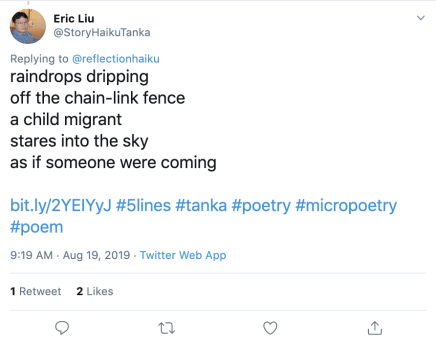
Image 1: Tweet by Eric Liu.
By measuring the difference between the sum of the hashtags used and the number of hashtags remaining after rerunning the combined data through the deduping process, we can gain a snapshot of how hashtags are being used to gain a larger audience. For instance, in 2011, there were only two instances of a tweet related to the writing community employing multiple hashtags. But in 2018, this number rose to nearly 73,600 from 5,654 the previous year, and in 2019, the number shot up dramatically to 318,550. The use of multiple hashtags to identify and disseminate original short stories or poetry on Twitter has been more steadily used, and every year since 2014, there have been between 86,000 and nearly 103,000 duplicate hashtags related to writing genres on Twitter (see Graph 2).
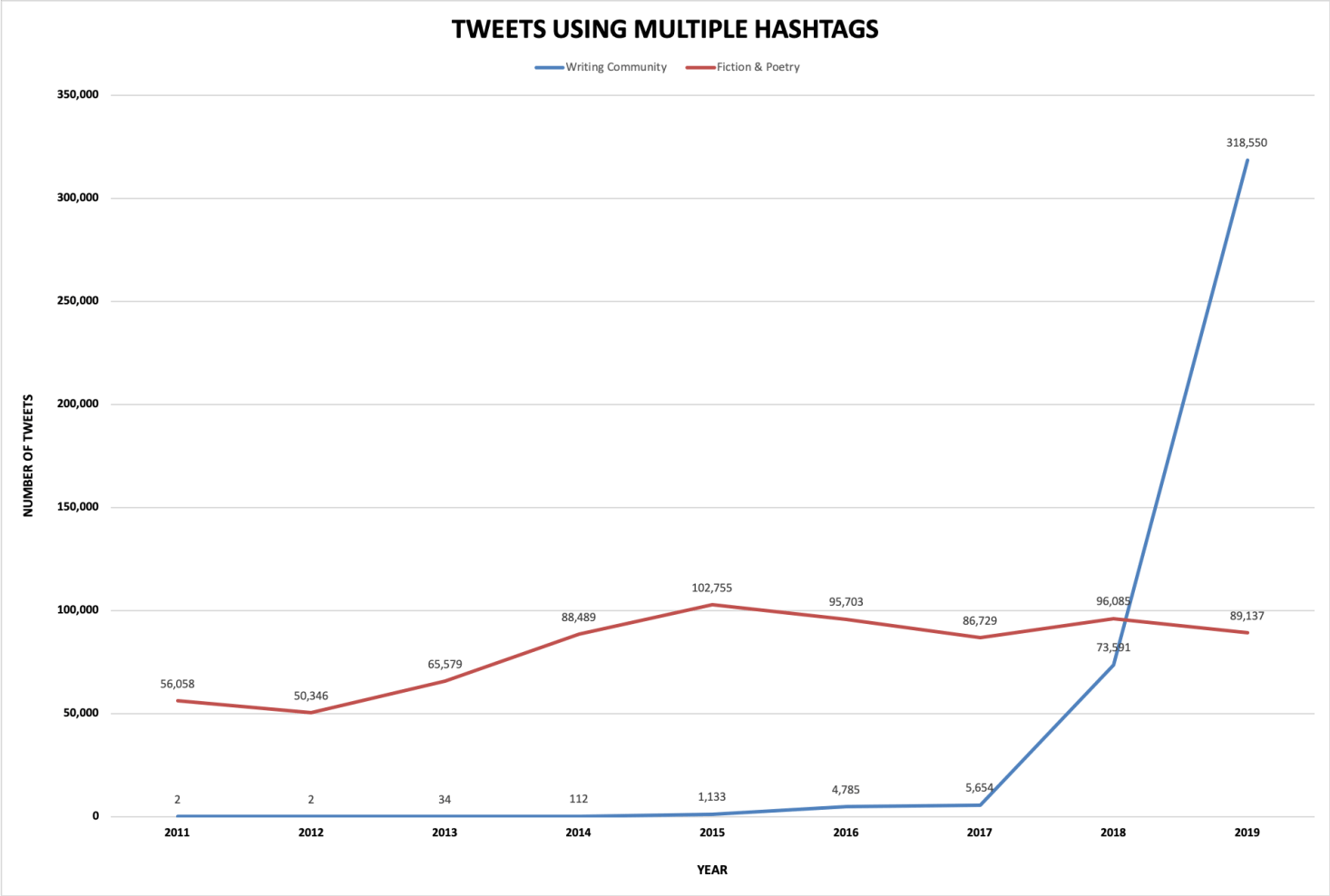
Graph 2: Number of hashtags used in tweets containing multiple hashtags.
Writing Community on Twitter
Graph 3 shows the combined use of hashtags related to the writing community (namely, #fictioncommunity, #poetrycommunity, #poetsociety, #writercommunity, #writerscommunity, #writingcommunity, #writernetwork, #writerslife, #writingsociety, and #writersoftwitter), between January 2011 through December 2019. Since 2015, there has been an explosion of growth in the Twitter writing community. In 2018 alone, the authors of nearly 900,000 tweets self-identified their posts as related to the Twitter writing community, and in 2019, this number jumped up to over 2 million. The increasing uses of these hashtags indicate a growing literary culture that is fusing literary and social concerns in a public and visible way.
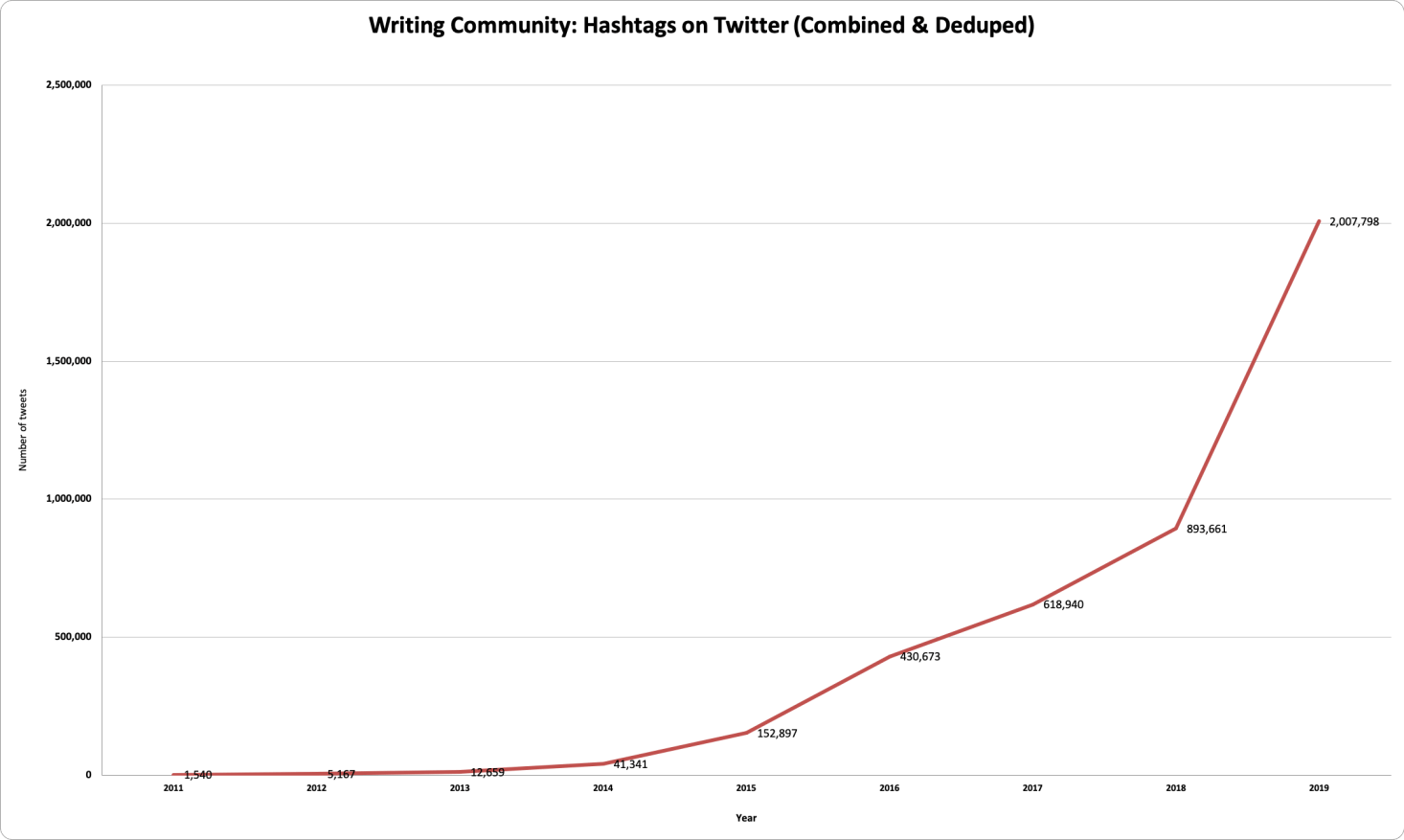
Graph 3: Use of hashtags related to the writing community on Twitter.
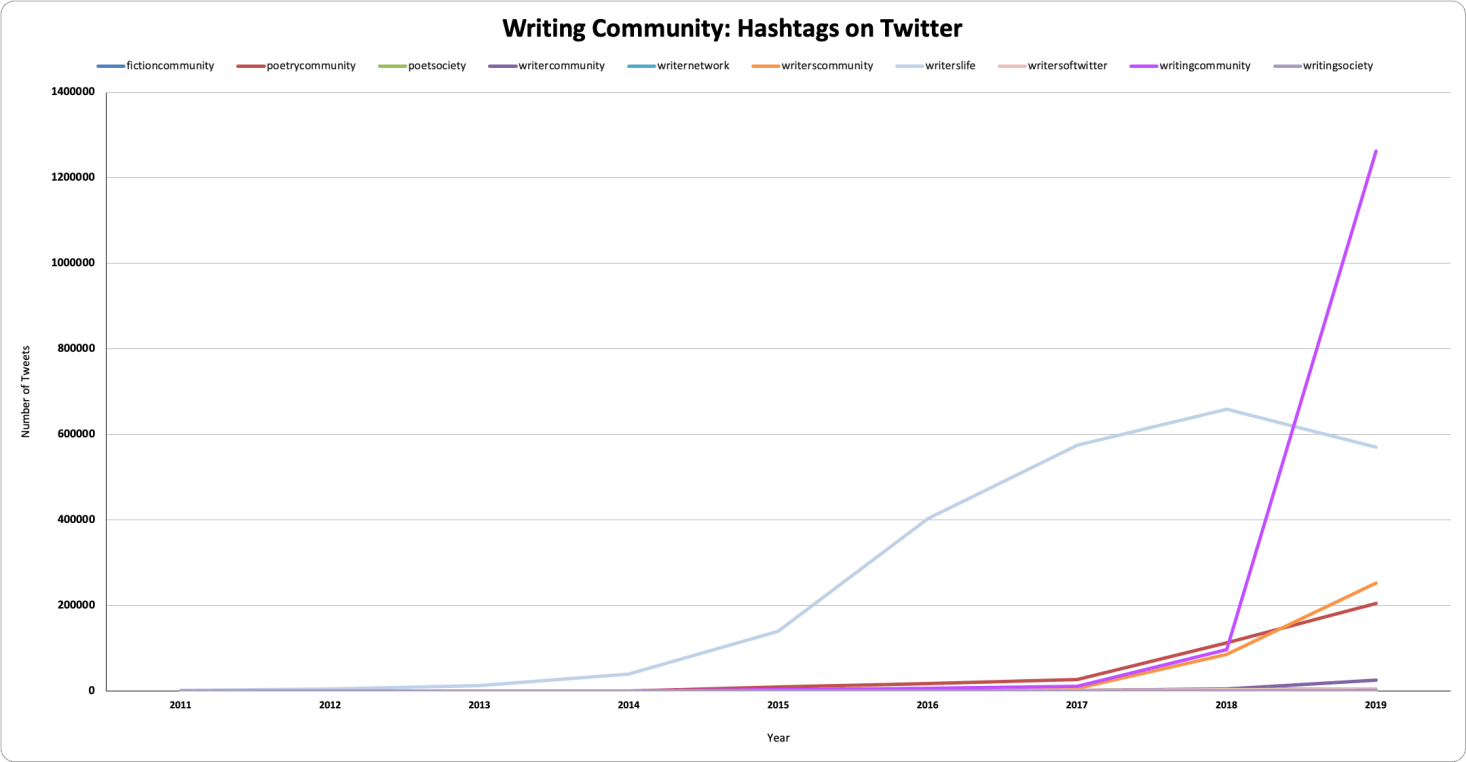
Graph 4: The Growth of the Writing Community on Twitter.
Graph 4 shows a breakdown of each of these terms. This graph reveals that the main source of growth for the Twitter writing community through 2018 was due to the popularity of the hashtag #writerslife. Between 2018 and 2019, however, a new hashtag term came to dominate the writing community scene, namely, #writingcommunity.
Genres and Forms of Twitter Literature
Graph 5 displays the number of tweets that have employed hashtags related to writing as a literary genre, form, or product (as opposed to a communal act). The twenty-five hashtags used to collect this data are: #3lines, #5lines, #flashfiction, #gogyoshi, #haiku, #microfiction, #micropoem, #micropoetry, #microtales, #nanotales, #poetryontwitter, #poetweet, #shortstories, #shortstory, #tanka, #twifi, #twitfic, #twitfiction, #twitlit, #twitterature, #twitterfiction, #twitterpoem, #twitterstory, #veryshortstory, and #vss. Unlike the explosion of growth that occurred within the Twitter writing community, the use of Twitter as a literary form changed steadily, reaching a peak of over 1.4 million users in 2015 before dipping again to around 1.1 million tweets per year in 2019.
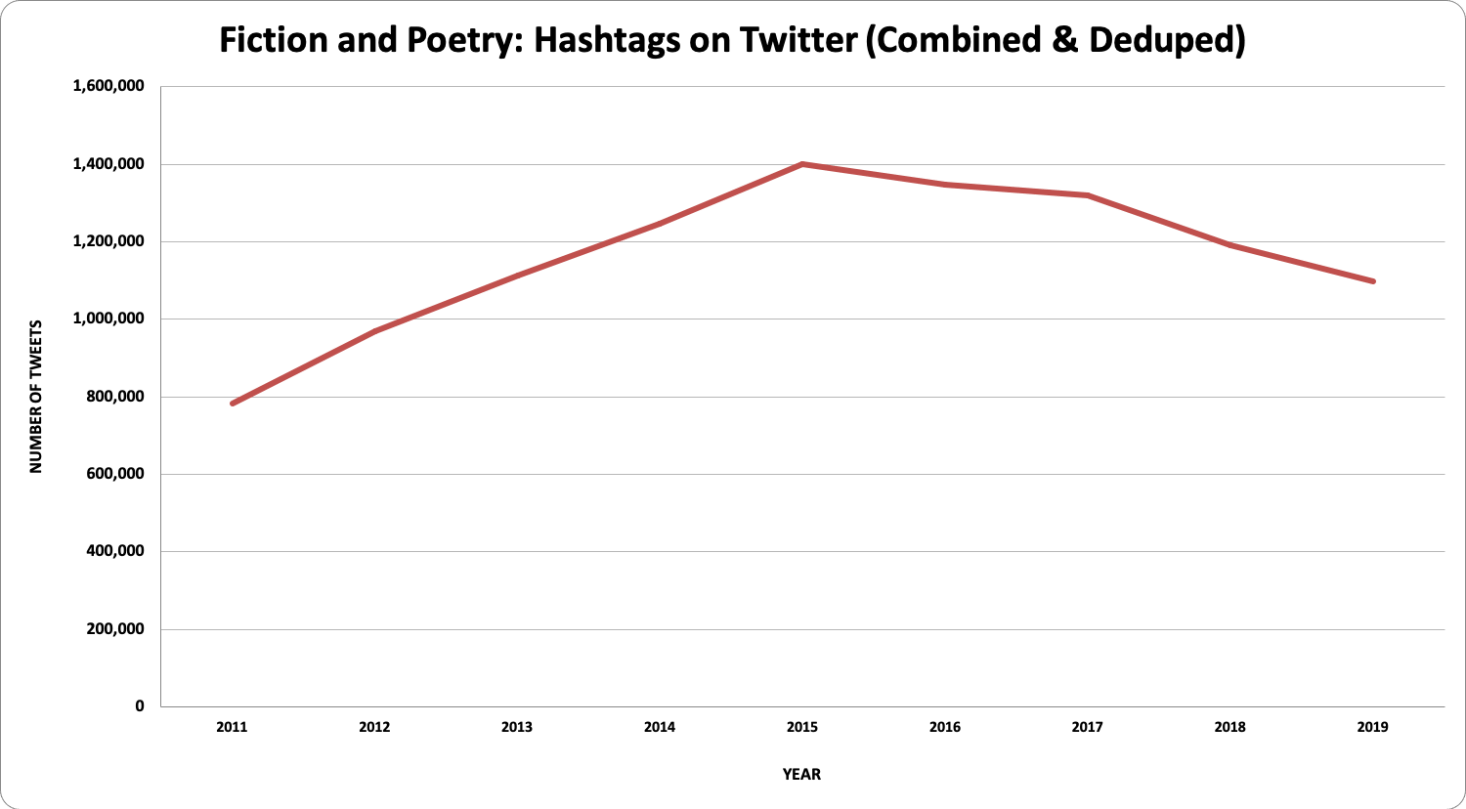
Graph 5: Number of tweets tagged with a fiction- or poetry-related hashtag.
To determine whether Twitter is simply the new “fad” for unconventional publishing, we reexamined the form or genre set of hashtags that we had gathered. We divided these hashtags into two further groups: those that explicitly reference Twitter (“TWITTER_Total”) and those that merely reference the literary form (such as #micropoetry or #tanka) (“FORM_Total”). The hashtags grouped under FORM are #3lines, #5lines, #flashfiction, #gogyoshi, #haiku, #microfiction, #micropoem, #micropoetry, #microtales, #nanotales, #shortstories, #shortstory, #tanka, #veryshortstory, and #vss; those grouped under TWITTER are #poetryontwitter, #poetweet, #twifi, #twitfic, #twitfiction, #twitlit, #twitterature, #twitterfiction, #twitterpoem, and #twitterstory (see Graph 6). As Graph 6 indicates, the use of hashtags related to form (with no reference to Twitter) have exploded, reaching over 1.4 million in 2015, after which the use of these hashtags fell to just under 1.2 million annually in 2019. Hashtags related to Twitter as specific publication platform, however, have seen much milder bursts of enthusiasm, reaching a peak in 2014 at nearly 100,000 tweets before plummeting sharply. In 2018, there were just under 7,000 uses of hashtags that explicitly referenced Twitter as a publication platform. This number increased slightly to just over 10,000 tweets in 2019.
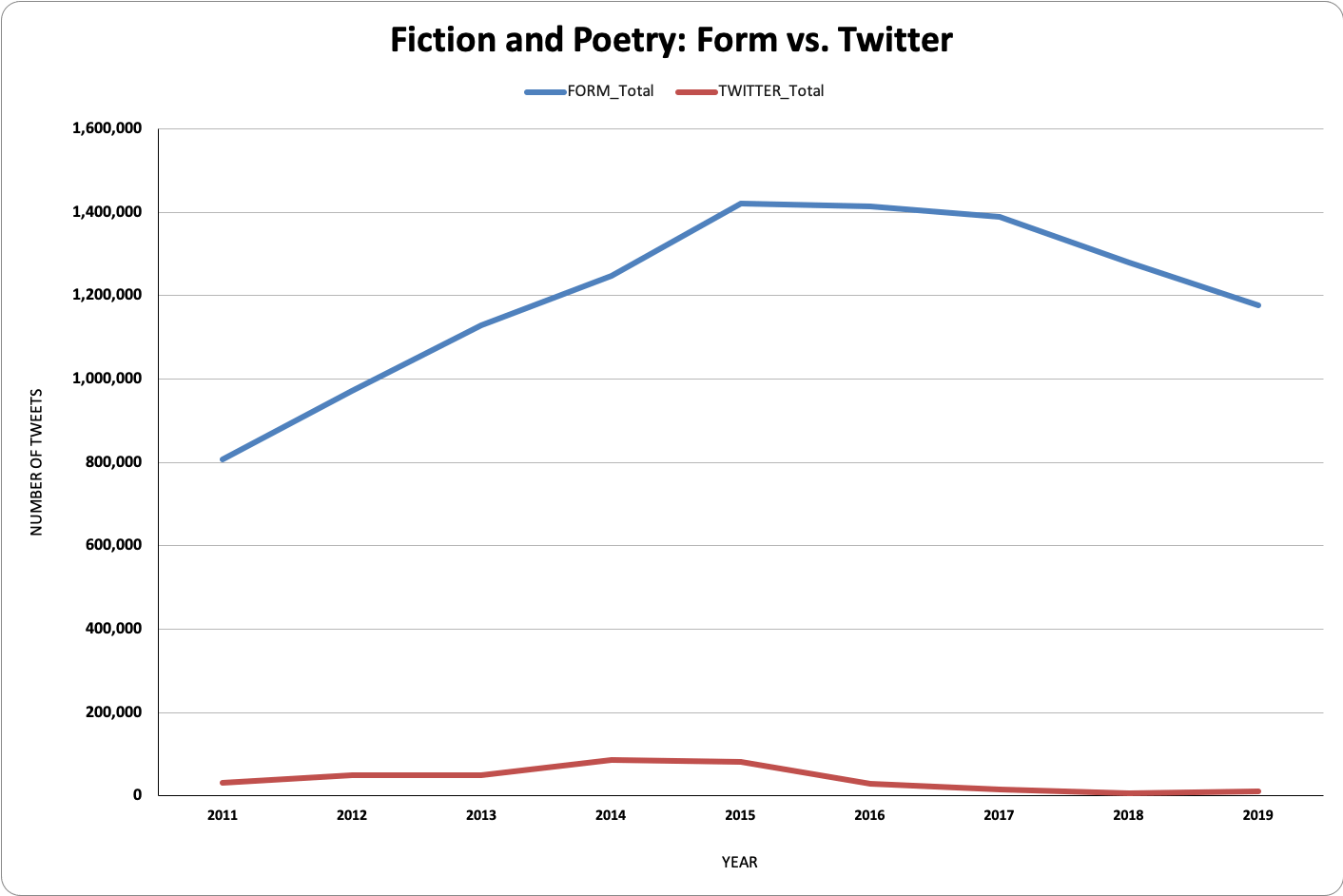
Graph 6: Breakdown of the use of hashtags related to fiction and poetry on Twitter.
But we can break this information down into even smaller units. Graphs 7-9 show the usage of specific hashtags between 2011 and 2018, categorized by their reference to either a popular form of writing or Twitter as a publication platform.
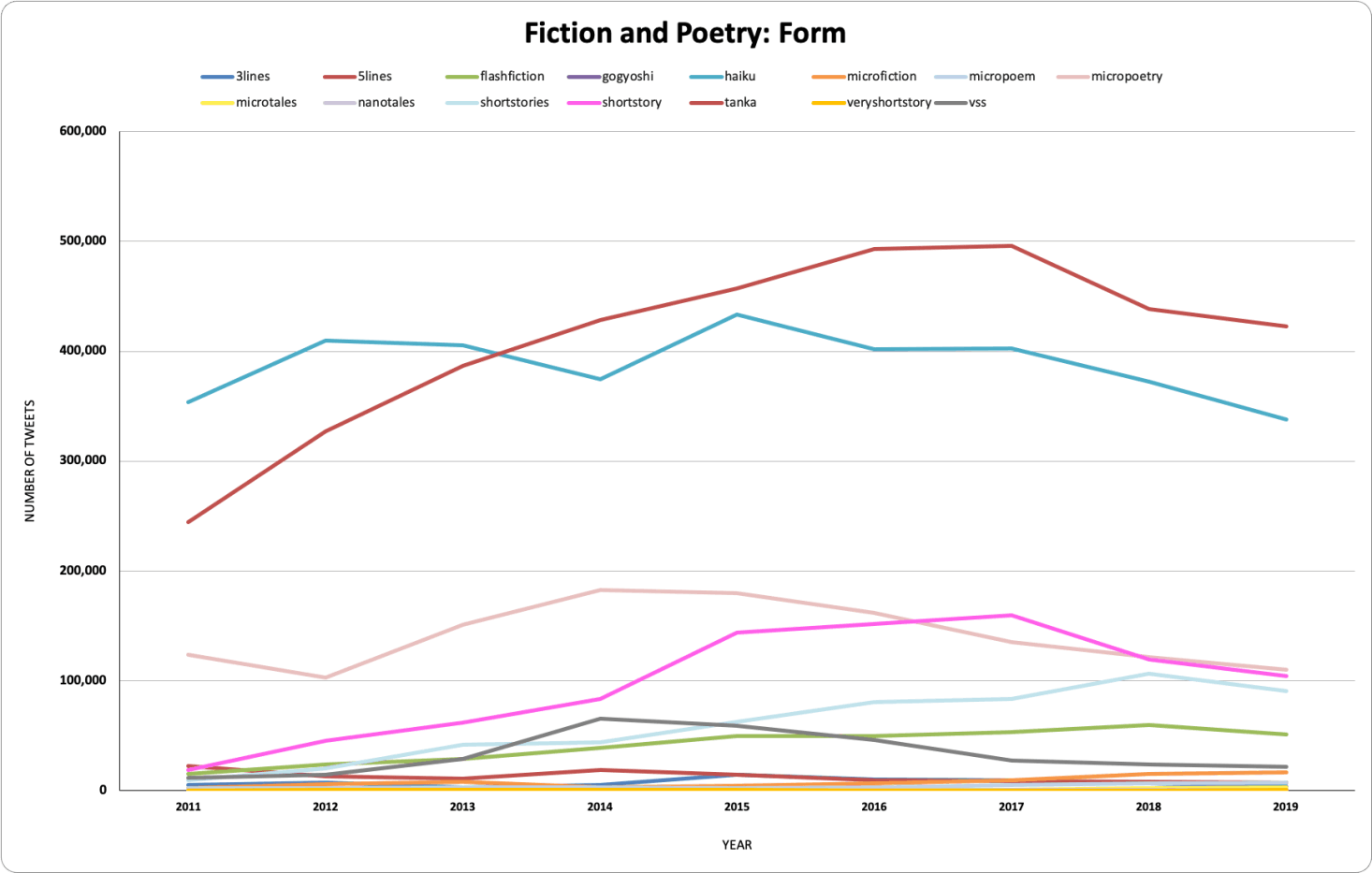
Graph 7: Use of hashtags related to popular literary form.
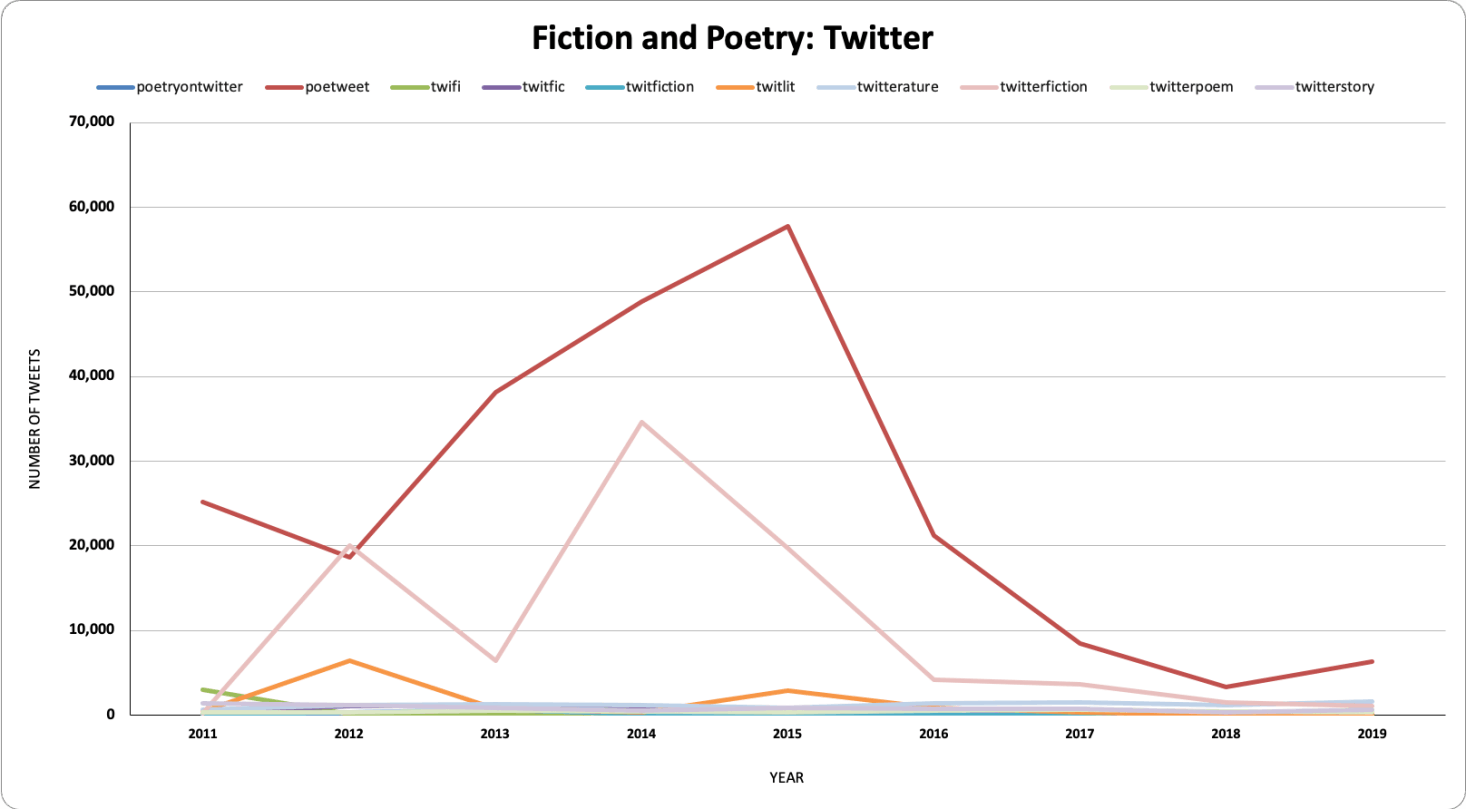
Graph 8: Use of hashtags related to literary form, specifically in reference to Twitter publication.
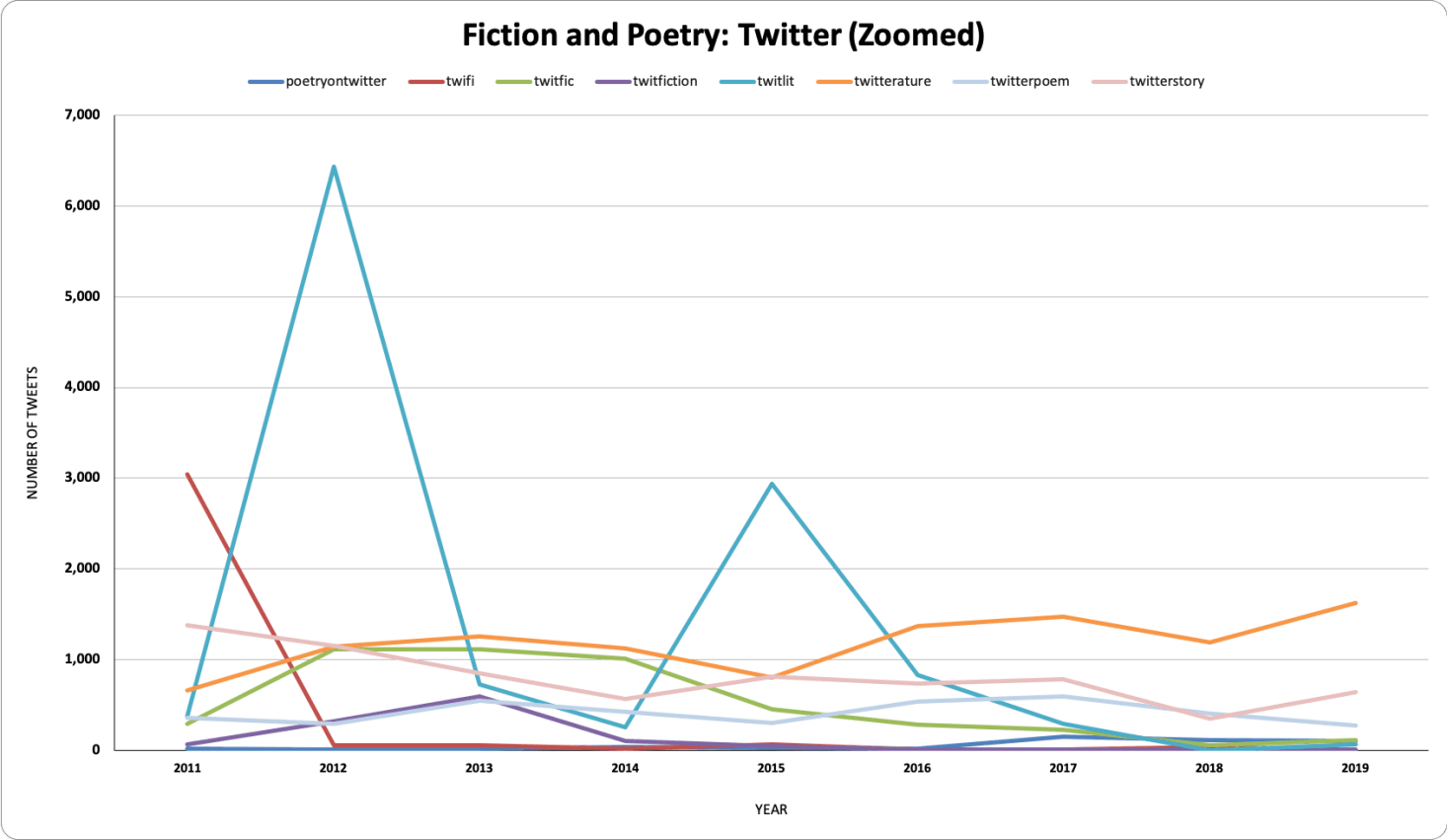
Graph 9: Use of hashtags related to literary form, specifically in reference to Twitter publication (detail).
The explicit reference to Twitter as a publication platform (such as in #twifi or #twitlit) might suggest that Twitter users see the publication of their work on this platform as partaking in a new fad. Yet if so, this fad has already seen its rise and eventual decline. In fact, a number of these Twitter-explicit hashtags have seen a rapid rise in popularity followed by just as rapid a decline. Witness, for instance, the erratic popularity of the term #twitterfiction in Graph 8 or #twitlit in Graph 9, which both radically change in popularity between 2011 and 2016 before ultimately falling into disuse. On the other hand, the literary hashtags that relate to form (including #haiku, #tanka, and #micropoetry) have much more gradually changed in popularity compared with their Twitter-inflected counterparts (#poetweet, #twitterfiction, #twifi). Such data indicates that the use of Twitter as a publication platform is stabilizing, and more writers are publishing poems and short stories on Twitter because Twitter has facilitated the publication and effortless sharing of shortened forms of writing.